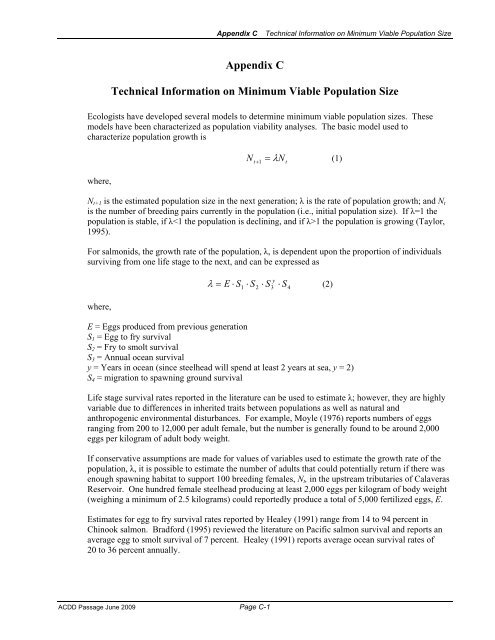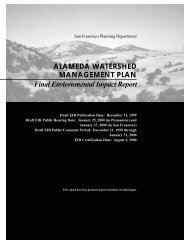Feasibility of Fish Passage at Alameda Creek Diversion Dam
Feasibility of Fish Passage at Alameda Creek Diversion Dam
Feasibility of Fish Passage at Alameda Creek Diversion Dam
You also want an ePaper? Increase the reach of your titles
YUMPU automatically turns print PDFs into web optimized ePapers that Google loves.
Appendix CTechnical Inform<strong>at</strong>ion on Minimum Viable Popul<strong>at</strong>ion SizeAppendix CTechnical Inform<strong>at</strong>ion on Minimum Viable Popul<strong>at</strong>ion SizeEcologists have developed several models to determine minimum viable popul<strong>at</strong>ion sizes. Thesemodels have been characterized as popul<strong>at</strong>ion viability analyses. The basic model used tocharacterize popul<strong>at</strong>ion growth iswhere,Nt+1 = λN t(1)N t+1 is the estim<strong>at</strong>ed popul<strong>at</strong>ion size in the next gener<strong>at</strong>ion; λ is the r<strong>at</strong>e <strong>of</strong> popul<strong>at</strong>ion growth; and N tis the number <strong>of</strong> breeding pairs currently in the popul<strong>at</strong>ion (i.e., initial popul<strong>at</strong>ion size). If λ=1 thepopul<strong>at</strong>ion is stable, if λ1 the popul<strong>at</strong>ion is growing (Taylor,1995).For salmonids, the growth r<strong>at</strong>e <strong>of</strong> the popul<strong>at</strong>ion, λ, is dependent upon the proportion <strong>of</strong> individualssurviving from one life stage to the next, and can be expressed aswhere,λ = E ⋅ S(2)1⋅ S2⋅ Sy 3⋅ S4E = Eggs produced from previous gener<strong>at</strong>ionS 1 = Egg to fry survivalS 2 = Fry to smolt survivalS 3 = Annual ocean survivaly = Years in ocean (since steelhead will spend <strong>at</strong> least 2 years <strong>at</strong> sea, y = 2)S 4 = migr<strong>at</strong>ion to spawning ground survivalLife stage survival r<strong>at</strong>es reported in the liter<strong>at</strong>ure can be used to estim<strong>at</strong>e λ; however, they are highlyvariable due to differences in inherited traits between popul<strong>at</strong>ions as well as n<strong>at</strong>ural andanthropogenic environmental disturbances. For example, Moyle (1976) reports numbers <strong>of</strong> eggsranging from 200 to 12,000 per adult female, but the number is generally found to be around 2,000eggs per kilogram <strong>of</strong> adult body weight.If conserv<strong>at</strong>ive assumptions are made for values <strong>of</strong> variables used to estim<strong>at</strong>e the growth r<strong>at</strong>e <strong>of</strong> thepopul<strong>at</strong>ion, λ, it is possible to estim<strong>at</strong>e the number <strong>of</strong> adults th<strong>at</strong> could potentially return if there wasenough spawning habit<strong>at</strong> to support 100 breeding females, N t , in the upstream tributaries <strong>of</strong> CalaverasReservoir. One hundred female steelhead producing <strong>at</strong> least 2,000 eggs per kilogram <strong>of</strong> body weight(weighing a minimum <strong>of</strong> 2.5 kilograms) could reportedly produce a total <strong>of</strong> 5,000 fertilized eggs, E.Estim<strong>at</strong>es for egg to fry survival r<strong>at</strong>es reported by Healey (1991) range from 14 to 94 percent inChinook salmon. Bradford (1995) reviewed the liter<strong>at</strong>ure on Pacific salmon survival and reports anaverage egg to smolt survival <strong>of</strong> 7 percent. Healey (1991) reports average ocean survival r<strong>at</strong>es <strong>of</strong>20 to 36 percent annually.ACDD <strong>Passage</strong> June 2009 Page C-1








